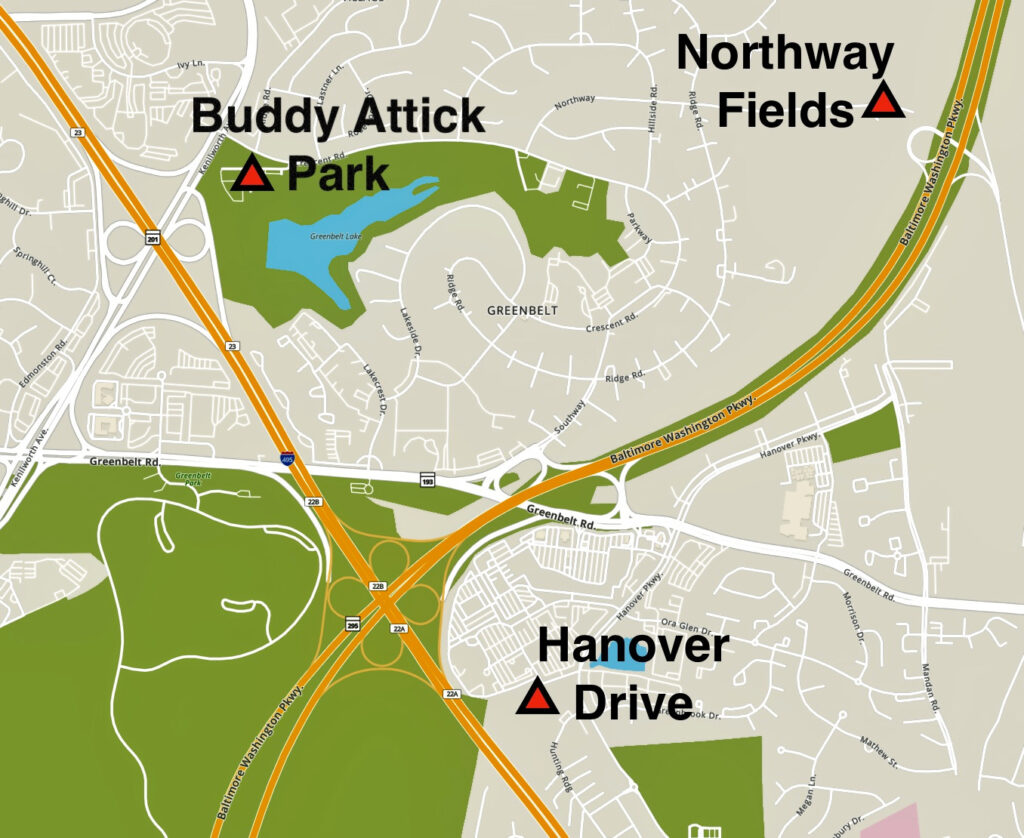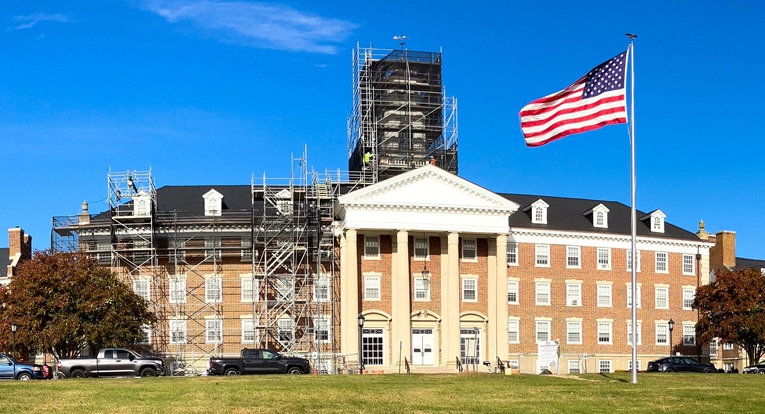At the March 13 council worksession, City Environmental Coordinator Kevin Carpenter-Driscoll addressed potential funding and initiatives related to the prevention of illegal dumping at three city facilities: the recycling center at Buddy Attick Park, the area next to the Northway ballfields and a lesser-known city recycling facility on Hanover Drive (see map, p.12). The request included money for gates, fencing and surveillance. But council rapidly segued into a more wide-ranging discussion of alternatives that also considered overall access to recycling facilities by resident homeowners and illegal access by others.
At the core of the discussion were the additional costs of illegal dumping to the city in labor and contract trash/recycling disposal, and the broader overall philosophy of the openness and availability of city-sponsored recycling.
Levels of Access
Councilmembers spoke up in favor of curbing illegal dumping while still allowing good access for homeowners but differed in how they thought both goals could be accomplished simultaneously. Councilmember Rodney Roberts was outspoken in defending open access to services that would encourage everybody to recycle – arguing that tightening the requirements, heightening security and restricting access would just result in more toxic waste dumped in the streams and woods. He felt that fences and gates would simply mean the debris got left at the gate instead of inside.
Mayor Emmett Jordan wanted homeowners to have access on the weekends as that would be when most of them had the time to recycle, whereas Carpenter-Driscoll advocated for business hours access only as a way to provide improved oversight because at those times, the sites were both accessible and monitored. Additionally, Carpenter-Driscoll advocated the same quarterly Saturday schedule for used oil collection as now exists for electronics recycling. Jordan doubted anybody wanted to keep used oil around until the next quarterly recycling day.
Councilmember Danielle McKinney was concerned about cost-benefit and wanted to know how much extra the various operations affected by illegal dumping were actually costing.
Oil Recycling
Carpenter-Driscoll promoted moving the oil recycling facility to a different location within the public works compound at Buddy Attick Park, fencing and gating it, installing cameras and limiting access most of the time to work-week hours with registered resident users having a keycode for access via an automatic gate. His plan included a new double-walled 500-gallon oil tank (furnished by the state) to replace the existing two 275 gallon single-walled tanks that are at the end of their useful life. The relocation and upgrade would involve around $8K to $9K in expenditures but would result in a facility that is more easily monitored.
Responding to questions from Councilmembers Kristen Weaver and McKinney, Carpenter-Driscoll noted that although the automatic gate was estimated to cost $27,000, the costs to the city now associated with illegal and improper dumping of hazardous waste at the recycling center and the Northway site are considerably more. He spoke of the specialized contractors required to handle illegally dumped hazardous materials and/or the use of city staff in cleanup operations at an annual aggregate cost over $50K. McKinney asked for data from last year to get a more exact cost. Roberts, Weaver and Pompi all objected to spending money on automated gates. Roberts felt they are an expensive item that requires ongoing maintenance and expense. Pompi objected to the one in Greenbelt East because she felt it wouldn’t solve the dumping problem and Weaver was concerned it was an unnecessary cost.
Northway Fields
The Northway site was also the subject of discussion with Roberts criticizing the city for dumping asphalt millings there that should have long-since been disposed of. Challenges with securing the site (which is a target for illegal dumping of construction waste) include shutting off the dump while still providing access for ballgames and the observatory. One proposal, for example, to place a gate near Ridge Road would mean scheduling openings for recreational activities, whereas gating and fencing only the area around the dump itself would not. Roberts stated once again that he thought fences and gates were pointless because people who were going to dump would do so anyway.
As a data point for comparison, council noted that the program providing free mulch to residents spends $30,000 annually to use on the mulch grinder and staff time to manage the mulch pile.
Access and Technology
City Manager Josué Salmerón described the city’s current thinking on controlling access and discouraging illegal dumping at the Northway Fields sites. With camera surveillance that notes vehicle tags, motion-activated lighting that spotlights vehicles approaching the gate (with due consideration to not scaring wildlife) and a gate that is shut (though not, in fact, actually locked) Salmerón felt, and council agreed, that dumping would be significantly discouraged. Council seemed to prefer a gate location closer to Ridge Road.
Longtime resident Tom Jones, a member of the Ultimate Frisbee group that has used Northway Field on Sunday mornings since 1993, explained that his group has occasionally seen a vehicle dumping and called the police. On one occasion, police intervened and made the miscreant reload the dumped materials.
Jones noted also that the field was in terrible shape. Resident Kevin Lockhart (Coach K) reinforced Jones’ comment on the state of the field, noting that in flag and regular football season, the Boys and Girls Club used that field Monday, Tuesday and Wednesday. He felt it was a real shame that Greenbelt kids had to play on such a substandard field.
In a historic note, William Orleans noted that Northway Fields is in fact the now grassed-over dump site for the city from when the original dump (in Greenbelt Park) was closed until the mid-1970s (waste now goes to the Prince George’s County landfill at Brown Station Road near Upper Marlboro). Orleans asked if the site was healthy – whether materials buried there could be hazardous – but the question was not taken up.
Greenbelt East Facility
The city’s suggestion is to enclose the Hanover Parkway facility (located near the dog park in Greenbelt East) with chain-link fence and an automatic gate (to allow independent access to contractors removing recycling). Contamination into the recycling bins is a significant issue, and as a result, the site is a big user of city staff time because it is so frequently misused.
Speaking from the floor, resident J Davis was adamant that the Hanover Parkway site is a failure. She said that so much miscellaneous stuff is dumped there that the contractor likely takes the dumpsters directly to the landfill and nothing at all gets recycled. She suggested that if the city is not going to invest in doing the Greenbelt East site properly, then they should just close it down because, she said, “It’s not doing any good whatsoever.”
Bulk Trash Day
Salmerón suggested a bulk trash day, where large items like mattresses could be put for disposal – and Jordan suggested it could be combined with other events. The cost is relatively easy to estimate. The idea resonated with council and will be researched. It should be noted that although those served by the city’s municipal trash pickup can confidently leave large items for collection, many of the condominiums and rental apartments have private pickup services that are less forgiving, leaving residents with large items and no way to dispose of them.
In summing up by the mayor and city manager, it was clear that no action was to be expected in the near future except for the ongoing camera evaluation, but both appeared satisfied that enough clarification had been made that more planning and evaluation for improved recycling could commence.




